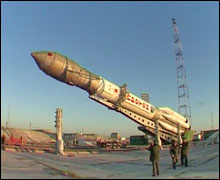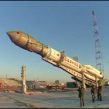
Moscow Attempts to Convince US and NATO it is Ready for a Nuclear Arms Race
Publication: Eurasia Daily Monitor Volume: 7 Issue: 220
By:

Russia has been long working to build an independent GPS (GLObal’’naya NAvigatsionnaya Sputnikovaya Sistema –GLONASS) system. Yet, on December 5, the program received a blow as 3 new GLONASS-M satellites plunged into the Pacific Ocean some 1,000 miles north of the Hawaiian Islands after a failed launch by a Proton-M rocket from Baikonur in Kazakhstan. Last week, in his annual national address President, Dmitry Medvedev, announced a serious high-tech achievement: “by the end of the year the GLONASS satellite system will be fully formed” (www.kremlin.ru, November 30). Now this goal has been postponed.
Medvedev, reacted angrily and promptly, ordering Russia’s Prosecutor-General, Yuri Chayka, and the Kremlin control directorate to investigate the causes of the crash, to verify the proper spending of GLONASS budget allocations and “report the names of the officials connected to what is happening” (RIA Novosti, December 5). According to Kremlin sources, “the GLONASS program is long-lasting, expenditure is high, military and civilian applications are important, but, regretfully, there is no result.” Chayka told journalists: “We are already working, if any wrongdoing is discovered, punishment will be severe” (Kommersant, December 7).
The faltering GLONASS began –like the US Global Positioning System (GPS)– purely as a Cold War military program. The first GLONASS satellite was launched in October 1982. In September 1993, GLONASS was officially declared operational by the defense ministry, though it had only 12 functioning satellites at the time instead of the required 24 to provide reliable global services. In December 1995, Russia managed to launch enough satellites to have 24 functioning in orbit, but soon after the system began to disintegrate. GLONASS satellites were unreliable and worked in orbit for only a couple of years at best, while the defense ministry did not have adequate funding to launch enough replacements. By 2001, there were only eight GLONASS satellites left in orbit. Also in 2001, the then President, Vladimir Putin, decreed a special federal program to revive GLONASS and make it equal to the US GPS, which today has 31 satellites in orbit. After almost ten years and spending $5 billion, GLONASS now has 26 satellites in orbit, but only 20 are at present fully functioning (Kommersant, December 7).
The Russian military wants to develop and deploy an array of relatively cheap precision-guided weapons (bombs, cruise missiles, etc), as their US counterparts have done. However, Russian leaders do not want to use GPS-targeting devices based on the Pentagon-controlled GPS that may be switched off, ciphered or distorted in time of war or crisis. The Russian defense industry has been developing GPS-jamming devices to disable enemy targeting and they could equally hinder any Russian-used GPS-equipment.
In addition to the military, the government has been pressing for civilian applications to make GLONASS navigation more widespread and profitable. In 2007 all restrictions on the civilian use of GLONASS were removed. Plans have been announced to equip all public land transport, ships and aircraft with GLONASS and to introduce prohibitive tariffs on the import of GPS navigators. Modified GLONASS-M satellites with a longer lifespan were introduced and a new GLONASS-K satellite is being developed that could reportedly work for up to ten years in orbit and prove “as good as the US-built GPS satellites” (RIA Novosti, December 5).
After the Proton-M failed, Anatoly Perminov, the chief of Russia’s space agency, Roscosmos, which is in charge of GLONASS, swiftly went into damage control mode. In an interview with Izvestiya, Perminov announced that a special commission with the defense ministry will investigate the crash. One of the GLONASS satellites “in reserve” in orbit may be activated. A new experimental GLONASS-K satellite is planned for launch later this month by a Soyuz rocket form Russian territory. According to Perminov, it was planned to test the GLONASS-K for three months, but it might be hastily integrated into the system. Six GLONASS-M satellites are today in construction and Perminov proposes to separately launch one nearing completion by next March from Russian territory, using a defense ministry Soyuz rocket, consequently by April 2011 the 24 satellites needed will be working in orbit (Izvestiya, December 7).
Reportedly, the Proton-M rocket failed, because workers at Baikonur, baffled by faulty equipment, pumped several tons of extra liquid oxygen into the fuel tanks of the DM-03 booster that should have sent the GLONASS-M satellites into high orbit. The Proton-M payload turned out to be too heavy and the rocket did not have enough thrust to reach orbit, sending the satellites attached to the DM-03 booster on a ballistic path into the Pacific Ocean (Interfax, December 8). Perminov announced: “The situation is unpleasant, but not a catastrophe: the missile launch pad was not destroyed and no one was killed” (Izvestiya, December 7). The Kremlin was not amused. Medvedev’s foreign policy aid, Sergei Prikhodko, lambasted Perminov for “using possible loss of life and launch pad destruction” as the only criteria of a serious failure to fulfill a “most important government program.” Prikhodko called Perminov’s excuses “unacceptable” and promised “serious decisions” for “inadequate self-criticism” (RIA Novosti, December 8).
Medvedev and Prime Minister, Vladimir Putin, have recently threatened the West with the prospect of a new arms race to press the US Senate to promptly ratify the New START arms control treaty and bully NATO into accepting Russian proposals on ballistic missile defense (EDM, December 2). Russian pundits have been promising that the Russian rocket industry is capable of revival and the Votkinsk rocket factory in the Urals may begin to produce up to 60 land-based intercontinental ballistic missiles (ICBM’s) (Kommersant, December 2). The GLONASS flop undermined the credibility of the Russian rocket industry at a really sensitive time, which could explain why foreign policy aid Prikhodko was so upset.
A test launch of the new submarine-based Bulava (SS-NX-30) submarine-launched ballistic missile (SLBM) is planned this month, before Christmas. The main designer of Bulava, Yuri Solomonov, announced the Bulava nuclear warheads are ready; the Votkinsk factory “produced up to 100 ICBM’s during the Cold War and may do it again;” the Bulava may be deployed on land in silos in addition to submarines and “may serve until 2050.” According Solomonov, the Bulava will be launched for the first time from the new Yuri Dolgoruky –the first nuclear submarine of the Borey-class, specifically built to carry the Bulava. The forthcoming launch will not be underwater, but from the surface (RIA Novosti, December 7).
A surface launch is considered safer and raises the probability of success. Yet, if something goes wrong again, the Kremlin’s fury may reach Cold War proportions and heads will roll.




